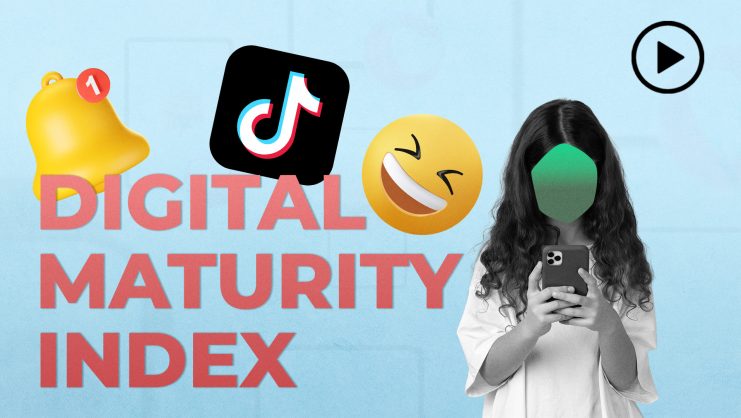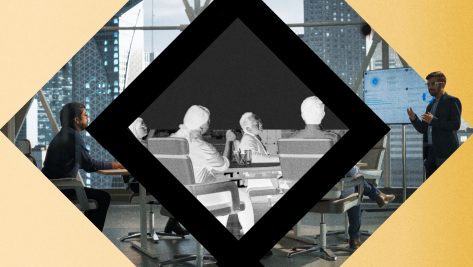Why has understanding human behavior become so important in business?
Understanding human behavior and what we know from behavioral science is very important in many ways in business. One example is what we call “nudging,” which is about designing small psychological pushes that guide people (employees, customers) towards desired behaviors. For example, some energy companies show you how your energy consumption compares to that of your neighbors’ on your monthly energy bill. If your energy consumption is higher than your neighbors’, you get a sad face; if it is lower, you get a smiley face. A simple change in the graphics and information provided in the monthly energy bill – comparing people to their neighbors and adding a face – has been shown to positively affect how much energy people use. That’s an example of how subtle psychological nudges can make a big difference in business.
Another important way that behavioral science shapes business is what we call “positive leadership.” We know from hard science, and particularly the field of positive psychology, that people’s daily emotions – the concrete, daily positives and negatives we all experience in a workday – can have a big impact on performance. For instance, we know that negative emotions we experience after a high-conflict meeting or when someone upsets us, can narrow our attention, making us less open to new or innovative ideas. At the same time, simply being in a negative emotional state can make us more likely to negatively misinterpret other people’s behavior or their intentions. On the other hand, when we experience positive emotions in the workplace, it can positively impact our behavior. For example, people who are experiencing positive emotions after a great team brainstorming meeting or a big success with a client tend to be more open-minded in their thinking and more creative in finding solutions to problems. They tend to have what we call a “lower psychological distance” from other people. As a result, if there’s a conflict or they’re negotiating, they tend to find more common ground than when they’re experiencing negative emotions. These are examples of how understanding positive psychology might help us better understand our own behavioral drivers and make changes in our daily experience to boost our productivity and effectiveness.
In addition to nudging and positive leadership, a third way that an understanding of human behavior can have an important impact on business is through behavior design. Right now, there’s a wonderful movement toward more structured approaches to understanding customer experience. There is a focus on the customer journey, on the different points at which a company interacts with the customer – with its products, services or employees. The aim is to understand the quality of those interactions and improve them. Understanding human behavior is critical here. For example, if we take psychology into consideration when redesigning the waiting room of a hospital, we can improve the customer experience by providing new and more real-time information to patients or people waiting for family members who are in surgery. We can use sensory marketing techniques to potentially improve the emotional climate in the waiting room. There are many aspects of psychology that we can take into account to help redesign the customer experience.
Understanding positive psychology might help us better understand our own behavioral drivers and make changes in our daily experience to boost our productivity and effectiveness.
How is wearable technology going to change the way we work and live?
There’s an interesting movement that some people call the “quantified self movement.” It refers to the idea that with the growing availability and sophistication of wearable devices and sensors – smart watches, smart phones, chips and devices we put in our shoes or under our mattress or pillow – that are collecting more and more data on our daily experience, for example data on our physiological state, sleep movements, or emotional arousal.
This is very interesting because one of the most important drivers of behavioral change is feedback. Typically, in our daily lives we get very little feedback on ourselves, either feedback from other people or from measurement devices. We may have low blood sugar, but it takes a while for us to realize it. In the interim, when our blood sugar is already very low, we tend to lose the ability to control our behavior, making us more likely to lose our temper in meetings or get frustrated with someone in a conversation. Having more real-time feedback on our moment-by-moment blood glucose level could allow us to actually adapt our behavior in more productive ways in real time. So that’s an example of how this self-measurement movement might shape behavior in the workplace.
It can also affect our lives in the sense that having feedback on how many steps we’re taking each day or on our heart rate variability can allow us to adopt a healthier lifestyle outside of work – which can then help us perform better when we’re at work. This data quantification movement is very exciting because it gives us the opportunity to better understand ourselves and the flow of our bodily and emotional states.
As another example, it is also now possible to measure our communications with devices that look like an employee ID badge. These devices can measure the tone and direction of your voice and how often you talk. Today, you can walk out of a meeting and get instant feedback on your communication style: how much you talked relative to other people, with whom you talked to more and less, what tones of voice you used with certain people and how emotionally aroused you were during a meeting. That’s fantastic information that can help us adapt our interpersonal behaviors to be more effective in working in group contexts. We can imagine that when all teams are using these kinds of self-quantification or self-measurement devices, it will provide a great new platform for improving team performance.
One of the most important drivers of behavioral change is feedback.
Why is it so important to combine data analytics with behavioral science when starting a business?
I’m a big proponent of data science. I believe in evidence-based management and thinking, where you don’t use intuition but make analytical-oriented business decisions based on facts and data.
However, as someone also trained in behavioral science, I know that the way human beings choose to collect information, the way we analyze that information, and the way we make final judgments or decisions based on information can be very biased. I am referring to well-known cognitive biases that people have studied, most famously, Daniel Kahneman, the psychologist who won the Nobel Prize in economics in 2002. For example, research has shown that in the moment we form an opinion or have an emerging mental proposal, we often unconsciously look for information that tends to support that opinion or proposal. We may evaluate neutral information in a way that we believe supports what we’re thinking. That’s one example of what we call “confirmation bias,” but there are many such types of very unconscious biases.
When you move to a world where people are using data all the time to make decisions, it’s very easy to forget that we as human beings are the ones who choose where to look for the data, how to collect and analyze it, how to visualize the data, and ultimately in most cases we make the final conclusions. So even though machines, computers, and algorithms are an increasingly important contributor to good decision-making, ultimately we have to understand some of the traps of human thinking when it comes to human decision-making and learn to avoid them. That’s why it’s important that people who are heavily involved in analytics and data-based decision-making also understand some of the psychological perils and traps involved.
How might technology change the way we train workplace behaviors, particularly soft skills?
One example of new and interesting technologies that I think hold great promise for improving the effectiveness of how we train behaviors and soft-skills in the workplace comes from the world of digital media.
We have technologies now for immersing ourselves in virtual realities, in digital or augmented realities that combine the real world with the virtual world. These technologies are extremely interesting, and they are evolving in sophistication very quickly. One way to use them would be in training communication skills. There are many training programs out there. You can read books on how to be a good speaker, how to be influential, how to give speeches or present information or pitch a business idea to potential investors. You can read a lot about it – and, if you’re lucky and someone pays to train you, you can give speeches or pitches in front of a coach or a small audience and get feedback from those people. But that’s very expensive, and you can’t do it frequently because it requires getting 10, 15, 100 people in a room to listen to you, paying a coach, and having someone there to evaluate your performance.
But now let’s imagine you put on virtual reality glasses. Now you’re immersed in an extremely realistic room of 400 people who are moving in their seats, checking their e-mail and their smart-phones, rolling their eyes, and yawning. You can imagine programming algorithmically specific behaviors to create a very engaged audience, a partially engaged audience, or a very disengaged audience. You, as the presenter, can then be in this virtual auditorium with those 400 people and try to give a good business presentation. While you’re giving it, the virtual attendees of your presentation can actually react in real time to what you’re doing based on an algorithm. You might program them to be a difficult crowd, so that if you start to pause between sentences or use the word “um” too many times, the digital attendees will start to roll their eyes, get bored, check their telephones, and move around in their seats. That gives you instant feedback, which you can then use to adapt. We can create very realistic virtual realities, so that people can practice their presentation skills over and over again under different scenarios. You can even imagine those virtual spaces providing some kind of dashboard, where you have a set of meters showing you how engaged the audience is, how much they are moving around. These devices could measure your heart rate, so you could be looking at 400 people in virtual reality and see whether your heart rate goes up or down. You could see whether you’re moving your own body too much or too little. You could have a meter that measures the modulation of your voice. You might set a voice modulation objective, because maybe you’re a person that’s too monotone, and you need to learn to modulate your voice better. This way, you can watch the voice modulation meter as you’re giving the presentation, and, if you’re not up to a certain level, you can take immediate action to improve it.
You can imagine how someone could practice with this virtual audience and, in a very short time, actually build voice and bodily modulation habits and become a much more engaging speaker. That’s one fairly detailed and concrete example of how digital media technology can be used to radically improve the effectiveness of soft skills training, in this case, for presentation skills. This is a radically higher ROI than anything possible now in verbal communications training.
Earlier, I also mentioned employee ID badges that can measure people’s communications in meetings and produce maps of the communication between them: who’s talking to whom, who’s not talking to whom, tone of voice. That kind of technology can also help us develop more balanced communication skills for working with other people in meetings. Likewise, I think we will soon see wearable technology able to measure our emotional arousal reasonably accurately. So we can imagine seeing data from high-conflict situations and getting feedback on how well we are able to manage our emotions during difficult moments in a day at work. Those are all examples of how technology, either by engaging people in virtual realities or measuring our behaviors, can give us much more feedback, more often, and at a much lower cost. We can then use that feedback to adapt our behaviors, practice new ones, and get into more productive habits. This is what I call “behavioral fitness training”.
In a certain sense, we are talking about networking with everything, with the entirety of the things we are connecting with, to get feedback and information from everything. Some call it the internet of bodies (similar to “the internet of things”). We are augmenting our bodies with devices and connecting ourselves to our cars, our bed, our refrigerator to obtain an integrated system for managing ourselves as bodies.
Technology, either by engaging people in virtual realities or measuring our behaviors, can give us much more feedback, more often, and at a much lower cost.
How can neuroscience and our understanding of the brain be used to make us more productive in the modern workplace?
There are increasing examples of how neuroscience is starting to inform some of the things happening in the business world and in the workplace. Of course, there’s neuro-marketing now, where we’re starting to measure how people’s brains react to different stimuli and applying that to marketing and consumer behavior.
One of the areas that in which I do training and teaching in is habit formation and behavior change. Here I draw directly on the neuroscience of habits and reward learning – how we learn from experience and start to form habits around our behaviors. This involves a neural system called the mesolimbic dopamine system. Dopamine is a neurotransmitter that has many functions, but one of these important functions relates to a reward-driven neural forecasting system that is what underlies habit formation.
Habits are automatic behaviors we engage in almost by default, without consciously thinking about doing them. There’s a system that develops those habits. When we do a behavior once, it’s obviously not a habit; we do it by choice, and in some contexts we may have to invest a lot of energy or “willpower” to make it happen (for example, going to the gym on raining weekend morning). But once we start repeating a behavior, and, in particular, once we start repeating it in the same kinds of contexts and situations and we receive rewards, a habit starts to form. What we know from neuroscience is that we can think about habits as habit loops or circuits and that they have three components.
The most important component is the actual behavior, that is, the behavioral routine that makes up the habit. For example, because many people in the modern workplace are busy and are short on time, they interrupt a lot in conversations. They have a habit of interrupting people when they’re talking. We could define “interrupting people while they’re still talking” as a behavioral routine.
If a particular behavior is a habit, then there is always something that triggers it: certain situations, a time of day, certain types of people, certain physiological states. Maybe you are a person who gets frustrated and impatient when you are with someone who tends to be very verbose and provide a lot of detail. You actually feel the frustration in your body; you want to move in your chair. All those things – your frustration, the feeling in your body, this particular person, this kind of context where somebody is talking in great detail – are part of the trigger, or “cue” that sets off your behavior of interrupting. So now we have two components: what triggers the behavior and the behavior itself.
The third component of the habit is the reward. This component has to exist for the habit system to be involved in automating the behavior. You always get something rewarding for doing a habit-forming behavior, and that is what makes your brain want to keep doing it. The rewards driving habit formation can be getting something positive. For example, when you interrupt somebody, by stopping the person from talking you might gain a sense of control over the agenda and a sense of renewed efficiency. It can also be rewarding to get rid of something negative. For example, by interrupting someone who is rambling on and on, you end the frustration and impatience that you feel while trying to keep listening. With a habit, there is always a reward.
By understanding these three components, you can actually train people to analyze unproductive behaviors that they want to change and help them come up with what I call a “habit hacking plan” to put in place more positive and productive behaviors. Not all habits are bad; many habits are good. But when an executive I work with says, “I want to learn to delegate more and control people less in projects,” we can then work together to unpack that person’s current habits. We identify what they do (their routine), why they do it (reward system), and the triggers (cues). Once they understand what drives their current behavior we then work to develop a plan for replacing the unproductive behavior with a more productive one, using along the way a broad range of behavioral tricks to make it easier for that person to make the new desired behavior more automatic. So that’s an example of neuroscience applied in a very concrete way.
There is a behavioral revolution that is starting to have important impacts on the way we organize, develop, and lead people.
Why is it so challenging for companies to innovate?
There are many reasons, of course, and it’s hard to distill it down to just one simple reason. One challenge, in my opinion, is that people are fundamentally very resistant to change. When you’re in a bad situation, of course you’re eager to change, and that’s a positive thing. But often, when people are in a good or even just a bearable situation, they are very resistant to change (sometimes without really being aware of this fact). We all intuitively know that people don’t generally like change in these contexts. The scientific question is why we are so resistant to change. One answer can be found in behavioral economics, in the psychology of decision-making. Daniel Kahneman, the Nobel laureate, found that when you give somebody a quantity of something – money, a trip, food, a bonus at work – they experience some amount of subjective pleasure. If you take the same thing away from the person once they already have it, it gives them much more pain than they experienced in getting it in the first place. Put more simply, negative things have about two to three times the impact on us psychologically as positive things.
Another important point is that whether we experienced something as positive or negative depends very much on a person’s frame of reference. For example, if you give an employee a 10.000€ bonus, they could interpret that as a wonderful thing and be very happy. But if they find out that a colleague got a 15.000€ bonus, now all of a sudden this bonus is no longer 10.000€; it’s negative 5.000€. So they’re on the other negative side of curve, even though they’ve received a large sum of money. So in the world of gains and losses, what people experience psychologically is very subjective.
Taken together, these findings shed light on why people resist change. Because negative things have roughly two to three times the impact on us as positive things, for people to be willing to make a change, the positives of the proposed change have to outweigh the negatives by a factor of about two or three. Unfortunately, that’s not always easy to do when you’re proposing a change, because people are already doing something a certain way, and they often frame situations mentally more in terms of the tangible costs of what they give up, and less in terms of the often less tangible benefits that might be gained.
This is often particularly true with changes involving investment or projects. When you make a change, you pay for it now, but the benefits usually come later. So there’s a delay in the positives, while the negative of investing the money happens now. Many things work against us, and what we find is that innovation is often hard, because people don’t like to change. The benefits of the innovation need to far outweigh the negatives, that is, the cost of the innovation, not objectively, but psychologically. Often, the people who propose innovations at companies spend a lot of time building a business case, an argument, for why the innovation needs to happen, why the planned change is better than the current way of doing things. What they don’t focus on enough is the psychological case for why the change needs to happen. They don’t sufficiently take into consideration the psychological negatives of what people are going to perceive that they lose. And they don’t sufficiently take into account the psychological positives that they could put into place to make the change more compelling.
That’s one very important reason why innovation is difficult, because you have to overcome this psychological change barrier that we know from compelling behavioral research.
As a closing point, I’d like to just note that it’s interesting that there are really two revolutions happening in modern business. One revolution is that decision making and business practices are increasingly being driven by data and analytics. Yet, in parallel, there is a behavioral revolution that is starting to have important impacts on the way we organize, develop, and lead people. Some people might see these two revolutions as counter to one another. I think they can and should be complementary.
© IE Insights.











